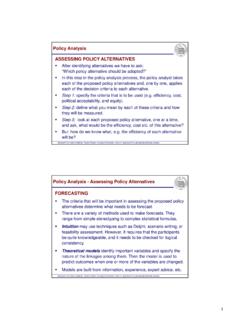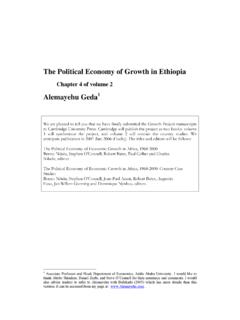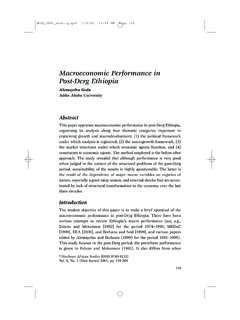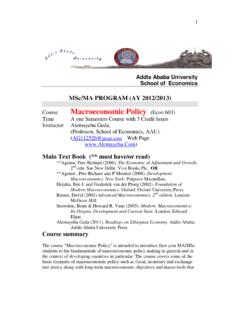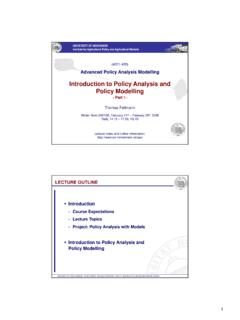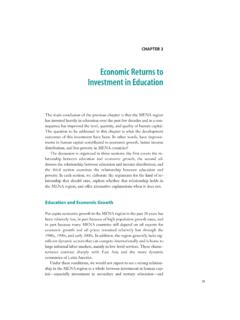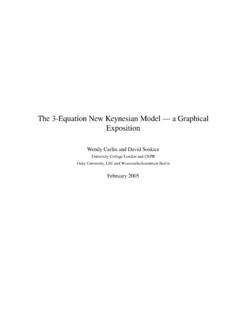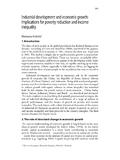Transcription of Econ 592: Advance Macroeconomics Solutions for Problem …
1 econ 592 : Advance MacroeconomicsSolutions for Problem Set 1 Romer, 2001 Problem to Zerfu January 8, 20071 Problem erentiating the LM equation,MP=L(i; Y)or equivalentlyM=P L(i; Y);withrespect toM;holdingPconstant:1 =P LididM+LYdYdM (1)Rearranging equation [1] to solve fordYdMyieldsdYdM=1P LY LiLydidM(2)Di erentiating the IS equation,Y=E(Y; i e; G; T);with respect to Mholding e; GandTconstant:dYdM=EYdYdM+Ei edidM(3)Rearranging equation [3] to solve fordidMyieldsdidM=(1 EY)Ei edYdM(4)Substituting equation [4] into equation [2]:dYdM=1P LY LiLY(1 EY)Ei edYdMCollecting the terms indYdMand obtaining a common denominator leaves uswith Contact address: FOR Problem SET 1dYdM LYEi e+Li(1 EY)LYEi e =1P LYSolving fordYdMyieldsdYdM=Ei eP[LYEi e+Li(1 EY)](5)Dividing the top and bottom of equation [5] byEi eyieldsdYdM=1 PhLY+Li(1 EY)Ei ei(6)To obtaindidM, substituting equation [5] into equation [4].
2 DidM=(1 EY)Ei eEi eP[LYEi e+Li(1 EY)]=(1 EY)P[LYEi e+Li(1 EY)](7)Dividing the top and bottom of equation [7] by(1 EY)gives usdidM=1 PhLYEi e(1 EY)+Lii<0(8)Looking at equation [6], sinceLY>0; Li<0; EY<1andEi e<0;wehavedYdM>0:In addition, note that the bigger isEi e(in absolute value) themore that planned expenditure responds to changes in the real interest rate- andthe smaller isLi- the less responsive is real money demand to changes in thenominal interest rate- the bigger isdYdM:Why? Suppose there is an increase inM:To re-establish money market equilibrium, we need a lower nominal interestrate at a given level of Y. All else equal, the smaller isLi, the bigger is the dropinirequired to re-establish this equilibrium.
3 The drop ini-which also meansa drop ini e;since eis assumed xed- then increases planned else equal, the bigger isEi e(in absolute value), the more that plannedexpenditure will rise. Thus the more that output will end up needing to rise tore-establish the equilibrium condition that output equals planned expenditureorY=E:2 Problem The equilibrium condition in the money market isMP=L(i; Y):Now supposethat the central bank has a target interest rate ofi=_i. At a given level ofY,demand for real money balances at the target interest rate would beL(_i ; Y). Toensure money market equilibrium, the central bank will simply have to adjustthe nominal money supply,M;to ensure thatMP=L(_i ; Y):Thus the LM curve FOR Problem SET 1the set of all combinations ofi and Ythat cause real money demand and supplyto be equal will be horizontal at the central bank s target level of the interestrate,_i :b.
4 The AD curve will now be vertical. First of all, why is AD downwardsloping when the central bank targetsMrather thani? At lowerP;MPishigher and thus the LM curve shifts down to the right. Thus the level ofYthat clears the money market and equates planned and actual expenditure isnow higher. The AD curve is all the combinations ofPandYthat clear themoney market and equate planned and actual expenditure. Hence lower levelsofPare associated with higher levels ofYalong the AD curve so that the ADis downward suppose the central bank is targeting the interest rate ati=_i. At lowerP, the real money supply would be higher.
5 But the horizontal LM curve will notshift. The central bank will simply lowerMso that at the given combination ofincome and_i,MP=L(_i ; Y)again. Thus a lowerPwill not require a higher levelofYto clear the money market and equate planned and actual is, regardless of the price level, there is one unique level ofYthat clearsthe money market and makes planned and actual expenditure equal the levelofYwhere the horizontal LM curve and IS intersect and thus the AD curve Problem (i) How does an equal increase inGandT a "balanced budget" increase ingovernment purchases a ect the position of the IS curve? We need to determinethe e ect onYfor a givenito examine the extent of the horizontal shift of theIS erentiating the IS curve,Y=C(Y T) +I(i e) +G;with respect toG:dYdG=@C@(Y T) dYdG dTdG +@i@(i e)d(i e)dG+ 1 Although continuing to use total derivative notation keep in mind that weare now holding eandiconstant.
6 In addition, we are assuming thatdT=dGand sodYdG=CY T dYdG 1 + 1!dYdG(1 CY T) = 1 CY Tor FOR Problem SET 1dYdGji fixed= 1 This can be interpreted as meaning the change inYfor a giveniis simplyequal to the change in government purchases. Thus, a change in governmentpurchases, when accompanied by an equal change in taxes, causes the IS curveto shift by a horizontal amount equal to that change in government (ii). Now we have to allow for a variable interest rate. We want to knowthe extent of the horizontal shift of the AD curve. That is, we want to knowthe e ect onYfor a givenP, but allowing for the e ects of a variable erentiating the IS curve equation,Y=C(Y T) +I(i e) +G;withrespect toG:dYdG=@C@(Y T) dYdG dTdG +@i@(i e) didG d edG + 1We are holding e(and P) constant, and assumingdT=dGso we havedYdG=CY TdYdG CY T+Ii edidG+ 1(1)Di erentiating the LM equation,MP=L(i; Y);with respect toG, holdingMandPconstant:0 =LididG+LYdYdGand rearranging to solve fordidGyieldsdidG= LYLidYdG(2)Substituting equation [2] into equation [1] yieldsdYdG=CY TdYdG CY T Ii eLYLidYdG+ 1 Solving fordYdG.
7 We havedYdGjP fixed=1 CY T1 CY T+ (Ii eLYLi)<1(3)The horizontal shift of the AD curve is thus"(1 CY T) 1 CY T+Ii eLYLi #dG < dG:The AD curve shifts less than the IS curve. This is because the shift of the ADtakes into account the rising interest rate caused by the upward sloping FOR Problem SET 1b. (i) We are now assuming that tax revenues are a function of income;T=T(Y). In addition,T0(Y)>0so that tax revenues rise when income nd the slope of the IS curve, di erentiateY=E(Y; i e; G; T(Y))withrespect toi, holding everything else constant:dYdi=EYdYdi+Ei e+ETT0(Y)dYdidYdi[1 EY ETT0(Y)] =Ei edYdi=Ei e[1 EY ETT0(Y)]Inverting the above expression yields the slope of the IS curve,didYjIS=1 EY ETT0(Y)Ei e<0(4)To see how an increase inT0(Y)a ects the slope, take the derivative of theexpression for the slope with respect toT0(Y):@(didYjIS)@T0(Y)= ETEi e<0sinceET; Ei e<0(5)Thus an increase inT0(Y)causes the slope fo the IS curve to become evenmore negative.
8 That is, it causes the IS curve to become (ii) We need to determine how an increase inT0(Y)a ects the impact onoutput, for a given price, of a change in G. First we need the e ect of a change inG on Y, for a given P. Di erentiate the IS equation,Y=E(Y; i e; G; T(Y));with respect to G, holding e( and P) constant:dYdG=EYdYdG+Ei edidG+EG 1 +ETT0(Y)dYdG(6)Di erentiating the LM equation,MP=L(i; Y);with respect toG, holdingMandPconstant:0 =LididG+LYdYdGdidG= LYLidYdG(7)Substituting equation [7] into equation [6]:dYdG=EYdYdG+Ei eLYLidYdG+EG+ETT0(Y)dYdGSolving FOR Problem SET 1dYdGjP fixed=EG1 EY+ (Ei eLYLi) ETT0(Y)>0(8)Now to see how the impact of a change in government purchases on output,for a given price level, is a ected by a rise inT0(Y) :@(dYdGjP fixed)@T0(Y)= EGh1 EY+ (Ei eLYLi) ETT0(Y)i2( ET)<0sinceEG>0.
9 ET<0(9)WhenT0(Y)is higher, the increase in Y, for a given P, due to an increasein G is smaller. Thus we have shown that the horizontal shift of the AD curvedue to a change in government purchases will be smaller, the larger isT0(Y):Now we need to determine how an increase inT0(Y)a ects the impacton output, for a given price, of a change in M. First we need the e ect of achange in M on Y, for a given P. Di erentiating the IS equation,Y=E(Y; i e; G; T(Y));with respect to M, holding G, e(and P) constant:dYdM=EYdYdM+Ei edidM+ETT0(Y)dYdM(10)Di erentiating the LM equation,MP=L(i; Y);with respect to M, holdingP constant:1P=LididM+LYdYdMdidM=1P Li LYLidYdM(11)Substituting equation [11] into equation [10]dYdM=EYdYdM+Ei eP Li Ei eLYLidYdM+ETT0(Y)dYdMSolving fordYdMyieldsdYdMjP fixed=Ei eP Lih1 EY+ (Ei eLYLi) ETT0(Y)i>0(12)To see how the impact of a change in M on Y, for a given P, is a ected bya rise inT0(Y), examine the following derivative:@ dYdMjP fixed @T0(Y)= Ei e( P LiET)(P Li)2h1 EY+ (Ei eLYLi) ETT0(Y)i2<0(13) FOR Problem SET 1 This derivative is negative sinceEi e; LiandETare all negative.
10 WhenT0(Y)is higher, the increase in Y, for a given P, due to an increase in M issmaller. Thus, the horizontal shift of the AD curve due to a change in thenominal quantity of money will be smaller whenT0(Y)is illustrates the concept of income taxes as automatic stabilizers. Wehave shown that the more that taxes increase with income, the smaller will bethe impact on output from shocks to the IS and LM curves such as changes ingovernment purchases or changes in the money Problem In a liquidity trap, the LM curve is horizontal at the low nominal interestrate that prevails. Intuitively, at a given interest rate, individuals are willingto hold any quantity of real money balances.
![Curriculum Vitae [1-April-97] - ::: …](/cache/preview/8/3/8/4/2/2/5/2/thumb-8384225265b34eac0963e7f7ecd24ea6.jpg)
